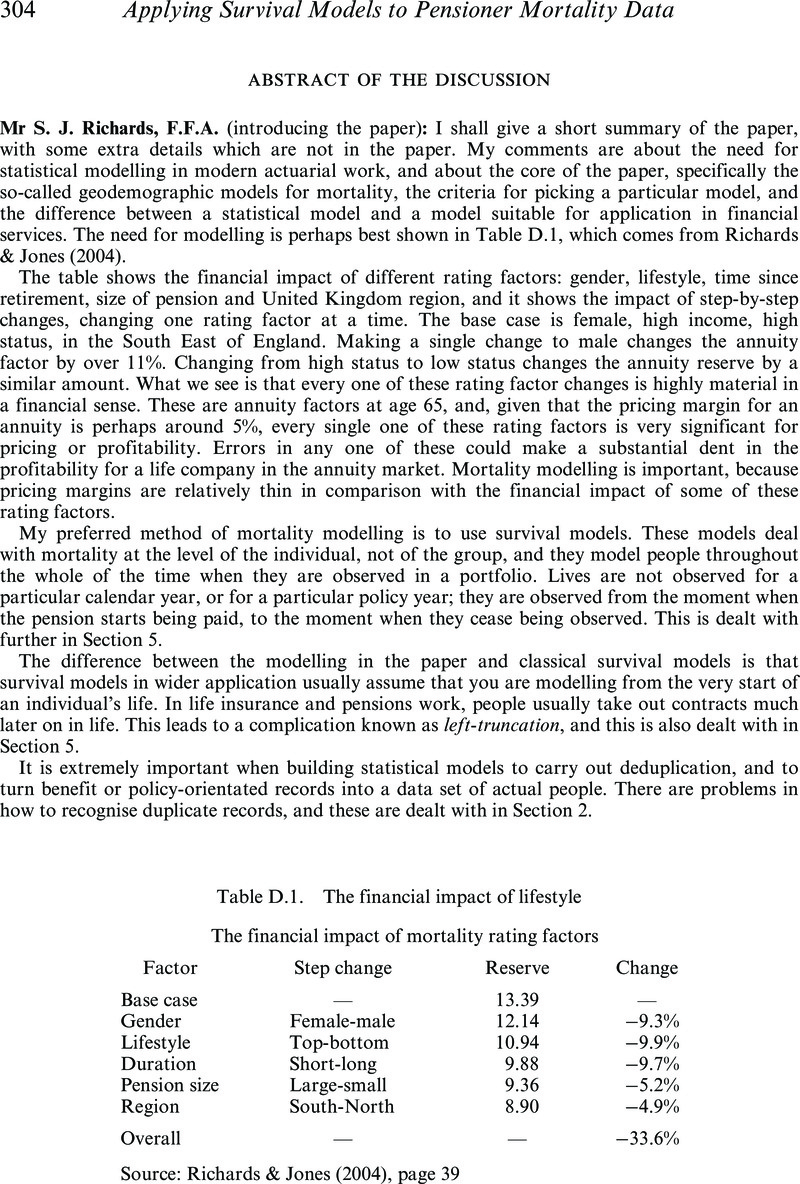No CrossRef data available.
Article contents
Applying Survival Models to Pensioner Mortality Data. Abstract of the Discussion
Published online by Cambridge University Press: 10 June 2011
Abstract
An abstract is not available for this content so a preview has been provided. Please use the Get access link above for information on how to access this content.

- Type
- Sessional meetings: papers and abstracts of discussions
- Information
- Copyright
- Copyright © Institute and Faculty of Actuaries 2008
References
Reference
Butt, Z. & Haberman, S. (2002). Application of frailty-based mortality models to insurance data. Actuarial Research Report No. 142. Cass Business School, City University.Google Scholar
Butt, Z. & Haberman, S. (2004). Application of frailty-based mortality models using generalized linear models. ASTIN Bulletin, 34, 175–198.CrossRefGoogle Scholar
Doray, L. (2008). Inference for logistic-type models for the force of mortality. Paper presented to the Society of Actuaries [Living to 100] Symposium, Orlando, Florida.Google Scholar
England, P. & Haberman, S. (1993). A new approach to the modelling of excess mortality. Journal of Actuarial Practice, 1, 85–117.Google Scholar
Hoem, J. (1990). Identifiability in hazard models with unobserved heterogeneity: the comparability of two apparently contradicting results. Theoretical Population Biology, 37, 124–128.CrossRefGoogle Scholar
Hougaard, P. (1984). Life table methods for heterogeneous populations: distributions describing heterogeneity. Biometrika, 71, 75–83.CrossRefGoogle Scholar
Ratkowsky, D. (1990). Handbook of nonlinear regression models. Marcel Dekker, New York.Google Scholar
Renshaw, A.E. (1988). Modelling excess mortality using GLIM. Journal of the Institute of Actuaries, 115, 295–312.CrossRefGoogle Scholar
Yashin, A., Vaupel, J. & Iachine, I. (1994). A duality in ageing: the equivalence of mortality models based on radically different concepts. Mechanisms of Ageing and Development, 74, 1–14.CrossRefGoogle ScholarPubMed
Reference
Forfar, D.O., McCutcheon, J.J. & Wilkie, A.D. (1988). On graduation by mathematical formulae. Transactions of the Faculty of Actuaries, 41, 97–269.CrossRefGoogle Scholar
References
Continuous Mortality Investigation Bureau (1976). CMIR 2, Institute of Actuaries and Faculty of Actuaries, 69.Google Scholar
Continuous Mortality Investigation Bureau (1999). CMIR 17, Institute of Actuaries and Faculty of Actuaries, 4.Google Scholar
Kaplan, E.L. & Meier, P. (1958). Nonparametric estimation from incomplete observations. Journal of the American Statistical Association, 53, 457–481.CrossRefGoogle Scholar
Nelder, J.A. (1977). A reformulation of linear models (with discussion). Journal of the Royal Statistical Society, Series A, 140, 76.CrossRefGoogle Scholar


